ANGLE BISECTOR THEOREM PROOF
Subscribe to our ▶️ YouTube channel 🔴 for the latest videos, updates, and tips.
Theorem
The internal (external) bisector of an angle of a triangle divides the opposite side internally (externally) in the ratio of the corresponding sides containing the angle.
Case (i) (Internally) :
Given : In ΔABC, AD is the internal bisector of ∠BAC which meets BC at D.
To prove : BD/DC = AB/AC.
Construction : Draw CE ∥ DA to meet BA produced at E.
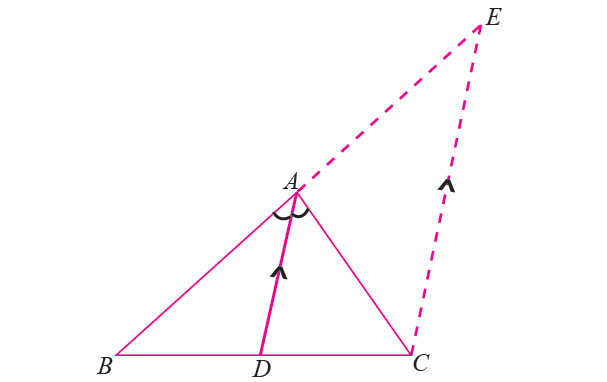
Proof (Internally) :
Because CE ∥ DA and AC is the transversal, we have
∠DAC = ∠ACE (alternate angles) -----(1)
and
∠BAD = ∠AEC (corresponding angles) -----(2)
Because AD is the angle bisector of ∠A,
∠BAD = ∠DAC -----(3)
From (1), (2) and (3), we have
∠ACE = ∠AEC
Thus in ΔACE, we have
AE = AC
(Sides opposite to equal angles are equal)
Now, in ΔBCE we have, CE ∥ DA.
By Thales Theorem,
BD/DC = BA/AE
Because AE = AC,
BD/DC = AB/AC
Hence the theorem.
Case (i) (Externally) :
Given : In ΔABC, AD is the external bisector of ∠BAC and intersects BC produced at D.
To prove : BD/DC = AB/AC
Construction : Draw CE ∥ DA meeting AB at E.
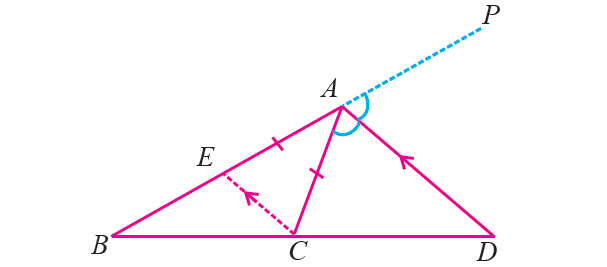
Proof (Externally) :
Because CE ∥ DA and AC is a transversal, we have
∠ECA = ∠CAD (alternate angles) ----(1)
Also, CE ∥ DA and BP is a transversal, we have
∠CEA = ∠DAP (corresponding angles) ----(2)
But AD is the bisector of ∠CAP,
∠CAD = ∠DAP ----(3)
From (1), (2) and (3), we have
∠CEA = ∠ECA
(Sides opposite to equal angles are equal)
In ΔBDA, we have EC ∥ AD.
By Thales Theorem,
BD/DC = BA/AE
Because AE = AC,
BD/DC = BA/AC
Hence the theorem.
Solved Problems
Problem 1 :
In the ΔABC shown below, find the length of BD.

Solution :
Since AD is the angle bisector of ∠A, by Angle Bisector Theorem,
BD/DC = AB/AC
Substitute.
BD/6 = 4/8
BD/6 = 1/2
Multiply each side by 6.
BD = 3
Problem 2 :
In the ΔABC shown below, find the length of CD.
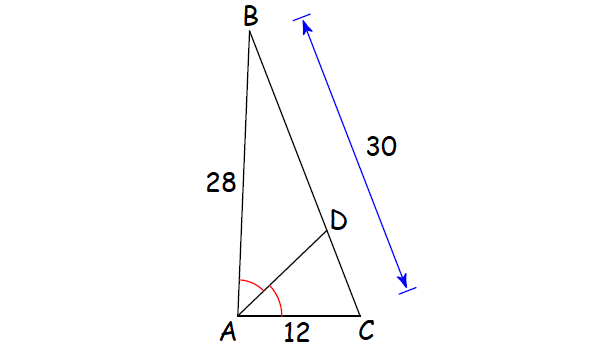
Solution :
Let x be the length of CD.
Then the length of DB = 30 - x.
Since AD is the angle bisector of ∠A, by Angle Bisector Theorem,
CD/DB = AC/AB
Substitute.
x/(30 - x) = 12/28
x/(30 - x) = 3/7
7x = 3(30 - x)
7x = 90 - 3x
Add 3x to each side.
10x = 90
Divide each side by 10.
x = 9
CD = 9
Problem 3 :
Solve for x.
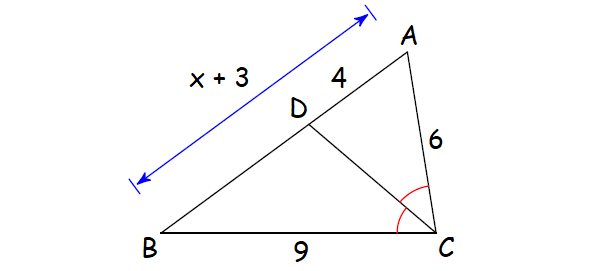
Solution :
Find the length of DB :
DB = AB - AD
= (x + 3) - 4
= x + 3 - 4
= x - 1
Since CD is the angle bisector of ∠C, by Angle Bisector Theorem,
AD/DB = CA/CB
Substitute.
4/(x - 1) = 6/9
4/(x - 1) = 2/3
3(4) = 2(x - 1)
12 = 2x - 2
Add 2 to each side.
14 = 2x
Divide each side by 2.
7 = x
So, the value of x is 7.
Problem 4 :
Solve for x.

Solution :
Find the length of AD :
AD = AC - DC
= 18 - 8
= 10
Since BD is the angle bisector of ∠B, by Angle Bisector Theorem,
CD/DA = BC/BA
Substitute.
8/10 = (2x - 4)/15
4/5 = (2x - 4)/15
15(4) = 5(2x - 4)
60 = 10x - 20
Add 20 to each side of the equation.
80 = 10x
Divide each side by 10.
8 = x
So, the value of x is 8.
Problem 5 :
In the figure given below, AD is the bisector of <A. If BD = 4 cm, DC = 3 cm and AB = 6 cm, find AC
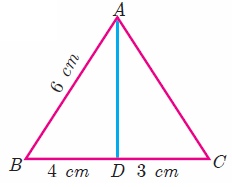
Solution :
AB/AC = BD/DC
Let AC = x
6/x = 4/3
3(6) = 4x
x = 18/4
x = 9/2
x = 4.5 cm
So, the measure of AC is 4.5 cm.
Problem 6 :
In the figure given below, AD is the bisector of <BAC , if AB = 10 cm, AC = 14 cm and BC = 6 cm. Find BD and DC.

Solution :
Using angle bisector theorem, we know that
AB/AC = BD/DC
10/14 = x/(6 - x)
Doing cross multiplication, we get
10(6 - x) = 14x
60 - 10x = 14x
60 = 14x + 10x
60 = 24x
x = 60/24
x = 2.5 cm
BD = 2.5 cm
DC = 6 - x
= 6 - 2.5
DC = 3.5 cm
Problem 7 :
In triangle ABC, AD is the bisector of <A meeting side BC at D, if AB = 10 cm, AC = 14 cm and BC = 6 cm, find BD and DC
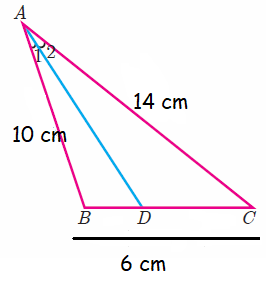
Solution :
Let BD = x, then DC = 6 - x
AB/AC = BD/DC
Doing cross multiplication, we get
10(6 - x) = 14x
60 - 10x = 14x
60 = 14x + 10x
60 = 24x
x = 60/24
x = 2.5 cm
BD = 2.5 cm
DC = 6 - x
= 6 - 2.5
DC = 3.5 cm
So, the measure of BD is 2.5 cm and DC is 3.5 cm.
Subscribe to our ▶️ YouTube channel 🔴 for the latest videos, updates, and tips.
Kindly mail your feedback to v4formath@gmail.com
We always appreciate your feedback.
About Us | Contact Us | Privacy Policy
©All rights reserved. onlinemath4all.com

Recent Articles
-
10 Hard SAT Math Questions (Part - 38)
Dec 29, 25 04:21 AM
10 Hard SAT Math Questions (Part - 38) -
10 Hard SAT Math Questions (Part - 39)
Dec 28, 25 11:20 PM
10 Hard SAT Math Questions (Part - 39) -
10 Hard SAT Math Questions (Part - 41)
Dec 28, 25 06:05 PM
10 Hard SAT Math Questions (Part - 41)

